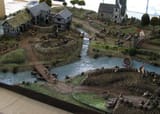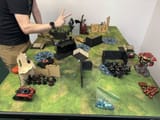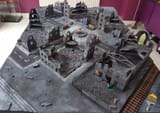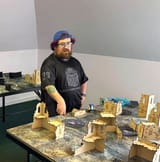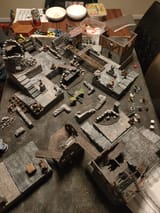>>96157985 (OP)
Here's my list:
-Modularity. The table shouldn't be a diorama, it should be able to be broken down and stored and set up in different positions. This could mean a diorama-style board broken down into tiles, or a flat board with moveable terrain pieces.
-Gameplay. Think about the requirements for your game- you can't play WHF on a dense table and you can't play 40K on an open one. Skirmish games should be *very* terrain-dense in places with some long sightlines and elevated positions for ranged play.
-Elevation. Provide it with books under a cloth (out of fashion these days but very effective), crafted hills, risers and multi-level ruins, sometimes one atop the other. Vital for proper tactics, vital for making the board look good.
-Verisimilitude. As
>>96158234 says, don't just scatter terrain: build the edge of a village, a particular Hive City zone, a section of countryside, but make it feel like a lived-in place that is now being fought over. How long have the buildings been ruined? Who's been living or surviving in them? Where's the main road, how are the settlement's water or power supplies met, where's the storage, signage, or civilian vehicles? What have the local population left behind when they fled, and how decayed is it? Just a few bits of specialised scatter terrain really make a difference here. Look at pictures, look at your local environment.
Finally, -Texture. You don't need detailed terrain paintjobs, but you do need concrete that kinda looks like concrete from a distance, stone like stone, grass like grass, metal like painted or rusted metal. This reason and this reason only is why MDF terrain looks shit out of the box; it needs texture.
Obviously I can't live up to all this, but at least knowing what you're aiming for makes a huge difference. Find your balance of practicality, gameplay and aesthetics. Have fun!
